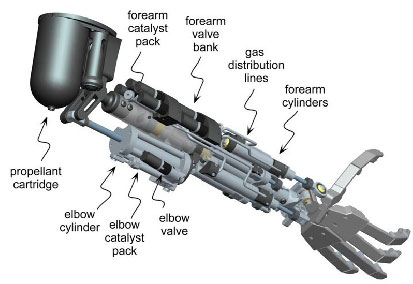The evolution of the prosthesis: from the battery to the rocket engine
Researchers at Vanderbilt University in the North American state of Tennessee presented a prototype of a mechanical prosthetic arm, controlled by a miniature rocket engine, to the public. In addition, this prosthesis also functions much better than the existing “analogs” (movement in the elbow joint, hand, fingers, palms are carried out independently of each other) and ten times “stronger”.

But the most important advantage of the prototype is that it does not require a battery. The power source is a small (pencil-sized) “engine” containing a catalyst that serves to ignite hydrogen peroxide. When hydrogen peroxide explodes, it creates pure steam, which is used to open and close several valves connected to joints and joints with several straps made of special monofilaments. A small tank with hydrogen peroxide, located at the top of the arm, is easily enough for 18 hours of the prosthesis.
In the process of development, scientists had to solve the problem of protecting a person using such a prosthesis from heating, which, for obvious reasons, accompanied the work of the engine. To do this, the researchers covered the “hottest” part of the mechanical arm with a millimeter layer of insulating plastic, which lowers the surface temperature to acceptable values. The removal of exhaust fumes also proved to be a problem. But she managed to solve the way as close as possible to natural. Steam is simply passed through a porous coating, where it condenses and is released as water droplets. The amount of water, according to scientists, does not exceed the amount of sweat that is released on the hands of a person on a hot day.
via Gizmowatch

But the most important advantage of the prototype is that it does not require a battery. The power source is a small (pencil-sized) “engine” containing a catalyst that serves to ignite hydrogen peroxide. When hydrogen peroxide explodes, it creates pure steam, which is used to open and close several valves connected to joints and joints with several straps made of special monofilaments. A small tank with hydrogen peroxide, located at the top of the arm, is easily enough for 18 hours of the prosthesis.
In the process of development, scientists had to solve the problem of protecting a person using such a prosthesis from heating, which, for obvious reasons, accompanied the work of the engine. To do this, the researchers covered the “hottest” part of the mechanical arm with a millimeter layer of insulating plastic, which lowers the surface temperature to acceptable values. The removal of exhaust fumes also proved to be a problem. But she managed to solve the way as close as possible to natural. Steam is simply passed through a porous coating, where it condenses and is released as water droplets. The amount of water, according to scientists, does not exceed the amount of sweat that is released on the hands of a person on a hot day.
via Gizmowatch
')
Source: https://habr.com/ru/post/13505/
All Articles